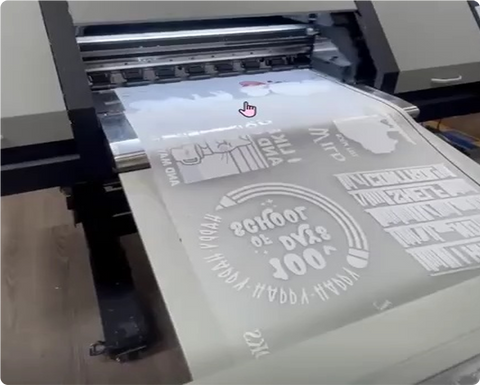Print On Demand (POD) is a business model where products—such as apparel, mugs, books, or art prints—are only manufactured after a customer places an order, eliminating inventory and upfront production costs.
Market Overview & Examples
-
The global POD market is projected to reach $12.96 billion in 2025, growing at a CAGR of ~25.3% toward $75 billion by 2033
-
Other estimates put market size at $8.45 billion in 2025, up from $6.65 billion in 2024
-
Popular POD categories include t-shirts, hoodies, mugs, phone cases, tote bags, books, and wall art
How Does Print On Demand Work?
Product Creation
You design graphics or artwork and upload them to your POD platform (e.g. Printful, Printify, Gelato). Use their tools to preview how designs look on selected product types.
Printing & Fulfillment
Once a customer orders, the POD provider takes care of printing, packaging, and shipping—leveraging local or global production networks.
Shipping & Customer Service
Orders are shipped directly to customers without inventory handling. Sellers often remain primary contact for customer support even if fulfillment is outsourced.
Advantages and Disadvantages of Print On Demand
| Advantages | Disadvantages |
|---|---|
| ✅ Low startup cost, no inventory, low risk | ❌ Higher per-item cost vs wholesale |
| ✅ Quick to market, scalable, flexible | ❌ Less control over production quality |
| ✅ Global reach via integrations (Shopify, Etsy, etc.) | ❌ Longer fulfillment times |
| ✅ Easy to test and iterate designs | ❌ Margins can be narrow and competitive |
-
Pros: low investment, fast setup, no inventory, global reach, design flexibility
-
Cons: higher unit costs, limited quality control, shipping depends on provider, you still handle customer support
Print On Demand vs. Dropshipping: Key Differences
Print On Demand is a subset of dropshipping focused specifically on customized, made-to-order goods. While both models outsource production and shipping, POD emphasizes branding and design, whereas dropshipping often involves sourcing generic products.
Differences include:
-
Design control: POD allows custom designs; dropshipping is reselling supplier catalogs.
-
Inventory risk: Both models avoid inventory, but POD has more variability in production times.
-
Margin: Dropshipping may offer lower margins due to lower perceived value, while POD margins range from ~20–60% depending on niche and pricing.
Best Print On Demand Companies in 2025
Based on SERP signals and authoritative sources, the top POD providers this year include:
-
Printful: Known for quality, branding options, global fulfillment, and integration with Shopify and Etsy.
-
Printify: Large global provider network allowing flexible pricing and shipping zones.
-
Gelato: Emphasizes local production to reduce shipping times and environmental footprint.
-
Shopify-recommended list: includes MerchOne, Lulu, Redbubble, others crop up frequently in reviews.
Is Print On Demand Profitable? (Expert Insights)
Yes, POD remains profitable in 2025, but competitiveness is increasing.
-
Most merchants report profit margins around 40–45% for mid-to-high volume sellers, meaning a $15 base item can yield $6–7 in profit when sold at $21–22.
-
Success rate: About 24% of POD stores remain active after 3+ years; 65% close within 1 year. Persistence and consistency matter.
-
First revenue milestone: On average it takes ~165 days to reach first $1,000; many sellers hit it under 118 days with perseverance.
How to Start a Print On Demand Business (Step‑by‑Step)
-
Choose a niche: focus on specific interests to reduce competition and appeal to targeted audiences.
-
Decide what to sell: popular items are t-shirts, mugs, stickers, tote bags—but niche-specific items may perform better.
-
Create designs: use tools like Canva or platform mockup generators. Ensure originality and avoid copyright issues.
-
Set up store: integrate POD app with Shopify, Etsy, WooCommerce, etc. Configure payment, shipping, and product listings.
-
Pick a provider: Evaluate by catalog diversity, quality, shipping, pricing, and user reviews. Request sample products to check quality.
-
Set prices: Cover base cost, shipping, fees, and desired margin. Compare similar products in your niche.
-
Test and launch: Start with a small set of products/designs. Collect feedback; iterate and expand.
-
Market your store: Leverage social media, SEO, influencer partnerships, paid ads to drive visitors.
Common Mistakes to Avoid
-
Skipping product quality checks: Without samples, you risk customer dissatisfaction.
-
Broad or overly crowded niches: Lower chance to stand out.
-
Ignoring IP rules: Avoid designs that infringe copyright.
-
Underpricing your products: Leaves little room for ads or discounts.
-
Neglecting customer service: POD providers handle production, but customer complaints come to you.
FAQs About Print On Demand
What is the difference between POD and dropshipping?
POD is dropshipping for customized products: you design, provider prints and ships after order.
How much does it cost to start a POD business?
Often zero to minimal cost—use free accounts on POD platforms, pay per order. Main investment is in design, domain, marketing.
What are the most profitable POD products?
Apparel (t-shirts, hoodies), mugs, home decor, phone cases. Niche-focused items may yield higher margins.
Can you start POD with no money?
Yes—you can build designs and stores for free. Cost only occurs when making a sale and ordering inventory through POD partner.
How long does POD shipping take?
Production typically takes a few days; shipping can vary depending on provider geography. Express options available via partners like Printify or Gelato.
Is Print On Demand Right for You?
Print On Demand remains a smart low-risk path into ecommerce in 2025. If you're a designer, creative, or side hustler with marketing commitment and a niche focus, POD offers scalability and minimal financial risk.
However, competition is high—only committed sellers offering unique designs, quality products, and strong customer experience tend to succeed.








